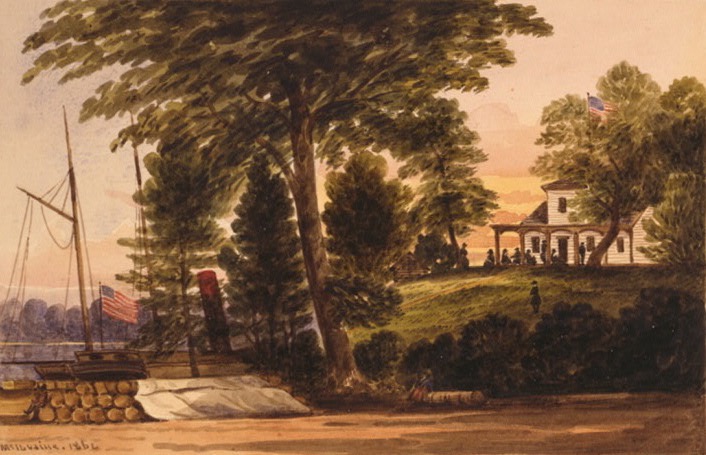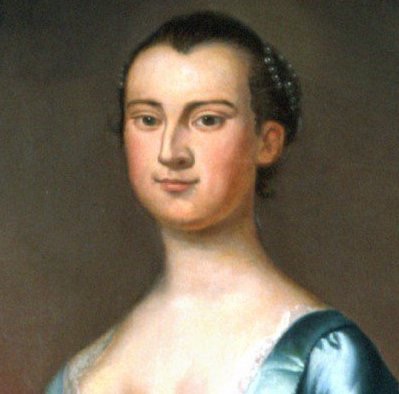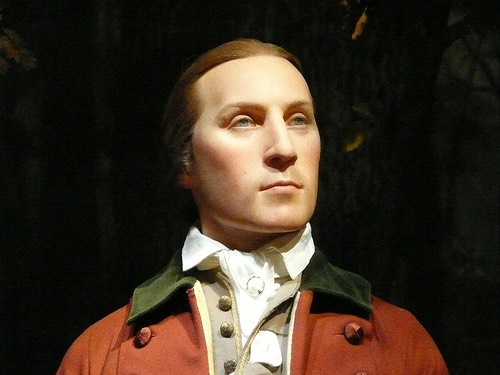By the time George Washington began his very brief courtship of Martha Dandridge Custis in March 1758, she had been married for eight years, given birth to four children, buried two of them, lost her husband, and had been a widow for nine months. Concerning adulthood with its responsibilities of tending to a spouse and children and running a household, Martha Custis had done it all; in those years, George Washington became a surveyor, became a warrior, and spent some time as a part-time farmer.
Martha, on the other hand, was a wife, mother, and for a time a surprisingly competent woman of business. At least she was competent according to recent biographers. Contemporaries were not so impressed with that aspect of her achievements, and possibly she wasn’t either. She seems to have felt that spending the better part of a year coping with lawyers, relatives, estates, and carnivorous London purchasing agents was quite long enough to play the part of a competent woman of business. She needed a careful business manager to handle her affairs. She married one.
The marriage of George Washington and the widowed Mrs. Custis melded four prominent Virginia families into an expanding matrix of influence and wealth. Those immediate families were Martha’s, the Dandridges; her late husband’s, the Parke and Custis families; and the Washingtons. The Dandridges were of old Virginia stock with connections relevant to people who kept genealogical charts of elaborate family trees in their heads. They were able to pin family names to places and people, to pieces of land, and even to particular houses. They meticulously sorted out bloodlines to ascertain social status, especially as it related to prospective marriages. Although not among Virginia’s oldest families, the Dandridges were people of a class that routinely arranged matrimony with money in mind and the vague hope that hearts would follow.
Martha’s parents had introduced her to Williamsburg society in 1746 when she was just fifteen. The custom was suited to the time, and her youthful debut wasn’t particularly remarkable. A woman was considered middle-aged in her mid-twenties, and Martha’s entrance into the capital’s social whirl was the typical course for a girl nearing marriageable age. Short at less than 5' and a bit squat in figure, she was as physically attractive as she would ever be in her life, and that was not much. But there was something else about her. As she moved into her late teens, she displayed a beguiling charm that made her popular, not because she was pretty but because she was nice. She laughed easily and often, and always at other people's jokes, never at other people. She doubtless realized that she was not much to look at, nor the sort of girl who made clever remarks or who could banter with sharp repartee, so she cultivated a natural talent for making everyone else feel smart and witty. As the years went by, she became more settled in these pleasant habits.
A girl is always attractive who is more interested than interesting, and boys of all ages have eternally found it a bewitching trait, sometimes without knowing why. In Martha’s case, she bewitched wealthy Daniel Custis so much that the ordinarily compliant young man defied his father’s objections. The elder Custis thought the little Dandridge girl was a fortune hunter, but Daniel married her, and they started a family. And if things had worked out differently, she would have spent her life at the Custis home called “White House” on Virginia’s Pamunkey River, made comfortable by Custis affluence and made happy by a loving husband and laughing children. But Daniel Custis died in the summer of 1757. He left Martha a widow at 26 with two kids, and his passing was so unexpected that he did not leave a will.

The White House on the Pamunkey River
Friends and counselors advised Martha to turn everything over to a trusted attorney because it seemed doubtful that she had the experience and the temperament to handle a complicated estate made doubly so by her husband’s death intestate. But Martha refused and took everything on herself. How much help she received from friendly advisors working without fee and able men of business drafting letters for her signature is impossible to say. According to the latest biographies, Martha astonished everyone in what proved to be her finest hour. Over the autumn, winter, and spring after Daniel's death, she remained steady and resolute, dealing with attorneys, colonial authorities, London agents, and her grieving children, all with the same sure hand and even temper.
Perhaps the problems associated with her late husband’s estate discouraged prospective suitors from paying court to the rich Widow Custis, for there is no evidence that the field was crowded. One serious caller was Charles Carter, the son of the long-dead Robert Carter, whose immense wealth had earned him the name “King” Carter, not necessarily as a compliment. Charles was known as Carter of Cleve after his elegant home on the Rappahannock. He was a courtly fellow with an impeccable pedigree who had nothing material to gain by marrying Martha. In fact, he seems to have been genuinely smitten with her. He was nearly fifty, though, and Martha hesitated over marrying a man who was likely to make her a widow again before she saw forty. Besides, Carter’s two previous marriages had produced no less than a dozen children, one nearly as old as Martha. She was polite, but nothing came of Carter’s efforts.

That was the situation in the spring of 1758. In March, she was visiting her neighbors the Chamberlaynes, who lived at Poplar Grove and operated a ferry there. Two riders approached the yard, dismounted, and while one held the horses, the taller one strode to the door. It was there in the parlor that Colonel George Washington just happened to run into the Widow Custis. Or so it was told.
Absent his diary, which has no entries for this span of months, and without any letters explaining their thinking, the best anyone can do is guess why Washington showed up at the Chamberlaynes that day. The meeting has the look of being arranged. Colonel Washington had returned from his latest western military campaign months earlier and was ill with a severe case of dysentery. Not only would it not go away, but it also seemed to reveal other dire maladies. Washington suspected that he had something fatally wrong with him. Tuberculosis came to mind, chillingly.
His trip to Williamsburg was to obtain an expert opinion, a purpose sufficiently urgent to make it unlikely he would go out of his way to visit people en route, especially casual acquaintances. He would have proceeded straight to the capital to have Dr. John Amson examine him as soon as possible. Washington was greatly relieved by the diagnosis. He was not dying. In fact, he was already on the mend. Leaving Williamsburg in a considerably better mood, Washington headed for the Chamberlaynes. Martha may not have known he was planning to visit, but he most likely knew she was there.
After this first encounter, their meetings were few, probably not more than and possibly fewer than three, and the courtship was brief. The brevity and the context of their association have suggested it was a business arrangement rather than a love match. It was, in any case, an unlikely match from several perspectives, and an unwise one for Martha. George had no real assets, had accumulated a fair amount of debt, had a demanding mother ensconced in the only house he owned, and was at the time leasing Mount Vernon from his former sister-in-law. To cap it off, he was ill, if recovering, but had a history of getting sick with surprising frequency.
None of that mattered to Martha. She could have been swept off her feet — Washington was tall, athletic, and gracious — but even if not, she must have been impressed with the earnest young man’s imposing physical presence and occasionally grave air. There was a steadiness about George Washington that a young widow with two small children and numerous responsibilities would find reassuring. At some point in June 1758, eleven months after Daniel's death, Martha and George came to an understanding, possibly even a formal engagement. He had by then received a ring purchased through the mail from Philadelphia.

In July, he was elected to the House of Burgesses for the first time, another sign of his growing status in the colony. The upcoming session early in the coming year made a winter wedding convenient. Washington had one more campaign in the West before he planned to resign his commission in the militia. As the summer passed into fall, this seemed to be the plan.
And then that September, Washington wrote a letter to his neighbor Sally Fairfax confessing his love for her. If nothing else, his communication with Sally provides compelling evidence that George Washington was marrying Martha Custis because he was a bit beyond the age when it was time to take a wife.
And yet, George Washington had found a treasure. Martha Dandridge had learned early that even a plain girl is made pretty by being interested rather than interesting. Martha Custis never forgot it, and as Martha Washington she would brim with love, freely giving it away with both hands, laughing often, embracing her family, her friends, keeping all close to her heart.
Possibly he knew that when, on January 6, 1759, he married Martha at the White House. The Reverend David Mossom conducted the ceremony. Mossom had been the vicar at St. Peter’s Church in New Kent County for almost thirty-five years and was a colorful character. His several marriages had provided him most recently, it was said, with a shrew, which was presumed to be the reason he occasionally departed from his text on Sundays to launch into ill-tempered rants.
Nothing of that sort marred George and Martha’s ceremony. She wore white satin decorated with silver threads, her back ornamented with satin ribbons in a leaf pattern and her front with a ribbon shaped like a butterfly. Pearls adorned her powdered hair, and shiny buckles set off her satin slippers.
After the vows, the White House became the scene of a prolonged celebration with neighbors and family drinking heartily and dancing long after the newlyweds had retired. In the weeks that followed, Washington attended sessions of the Burgesses, so they remained in or near Williamsburg until the spring.
Although it seems that living at Mount Vernon was a foregone conclusion, it didn’t have to be. Martha owned two houses outright, the one on the Pamunkey and another in Williamsburg, but there doesn’t seem to have been any doubt that the family would decamp for permanent residence at his place on the Potomac. Most of her possessions went by water out of the York River. Martha with her children Jacky and Patsy rode in a coach drawn by four horses. Washington was on horseback, and an entourage trailed behind. The caravan made stops for social calls, first at Fielding and Betty Lewis’s home, then at Ferry Farm for Martha to meet his mother. Continuing, they crossed Belmont Bay on the Colchester Ferry and made their way toward Mount Vernon along the edge of the Fairfax estate.
They approached Mount Vernon from the West, and Martha’s first sight of the place treated her to the vista that always made a lasting impression on new visitors. Spring meant the grounds were at their best, and orchards filled the air with sweet scents. Washington was vexed that some of the renovations begun almost two years earlier were still under way. Despite his hastily dispatched instructions to his servant John Alton to have everything in order, the place smelled of wet paint and drying plaster. Martha didn’t mind.
Soft days passed into pleasant nights cooled by Potomac breezes. The house high atop its impressive little mountain might smell of linseed oil and tremble during the day from hammering workmen, but she didn’t mind, and even a case of the measles could not dampen her spirits. Things had worked out pretty well after all for the little Dandridge girl who had known so much heartbreak so early. Her children played, her husband was attentive even when busy, and she was mistress of a fine farm. And though they were of that class of people who often arranged matrimony with money in mind, there was likely the vague hope that hearts would follow.
Hers already had.